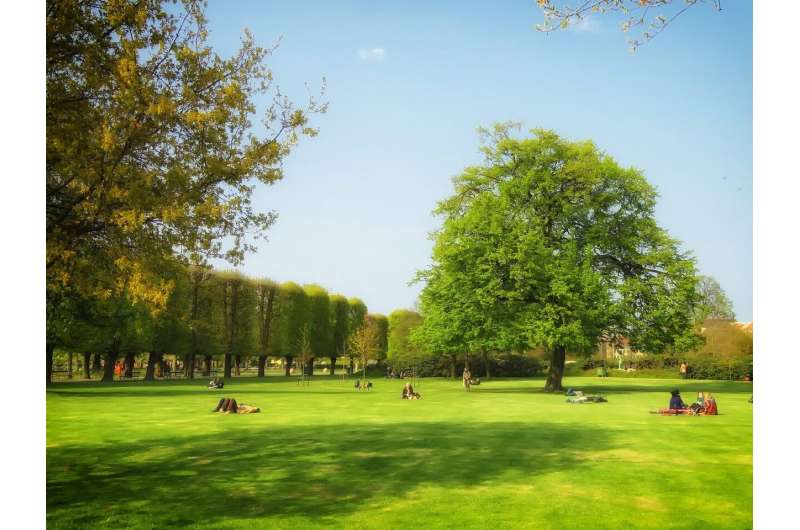Parks are about promoting everyone's public health, not just boosting homeowners' property value

The COVID-19 pandemic put a lot of attention on the role of parks and green spaces —particularly in large cities. But, not all of this attention has been positive.
Although the pandemic has clarified the beneficial role of parks in promoting health and well-being in urban communities, it has also highlighted inequities in accessing parks and green spaces, problems with a culture of enforcement and led to a series of policy responses that were heavily criticized.
Recently, police in Halifax clashed with protesters and violently evicted people staying at Peace and Friendship Park and Spring Garden Road Library. Earlier this summer, Toronto police forcibly evicted residents living in encampments at Lamport Stadium, Trinity Bellwoods Park and Alexandra Park. Under the guise of "park remediation" these violent evictions were described as reasonable, firm and compassionate by Mayor John Tory despite the clashes with protesters, use of pepper spray and numerous injuries and arrests.
These actions have been repeatedly justified as a means of protecting public safety, but activists, health experts and even city councilors have spoken out against the use of violence in these responses.
Although current events have created a buzz, they reflect a trend in public policy that has been developing for some time and changing the way we see, use and value parks in our cities. They also highlight some of the limitations in our thinking about how parks can serve as a health resource for our communities.
Multiple visions of urban parks
The idea of parks as a public health resource was central in the early vision of parks. In the Progressive Era (1896–1916), an interest in health and hygiene motivated the development of parks so there could be clean and sanitary spaces for outdoor play in the overcrowded conditions of growing industrial towns.
However, other visions and motivations have long driven urban park development. City boosters and beautification societies invested in parks as a way to create civic landmarks and spaces of esthetic and natural beauty for residents to enjoy as leisure. Middle-class social reformers saw parks as spaces for the social improvement of the working class through organized sport and physical education. Public parks have long been valued as spaces for urban amusement and entertainment.
Our vision of urban parks —particularly in large cities like Toronto —is also affected by broader economic conditions, local development agendas and gentrification.
Parks advocacy groups actively promoted the health benefits of parks as a strategy to promote park investment in cities during periods of chronic underfunding. For some advocates of urban development, parks tend to be positioned as a leisure resource for homeowners and a source of property value. This is reflective of broader social trends where private wealth is valued over public goods.
The logics of park policy
Park-related policy is generally established at the municipal level. Examining policy implementation and enforcement helps us understand the motivations that guide policy development.
The events that unfolded in Trinity Bellwoods Park during the pandemic illuminate some of the gaps between the rhetoric of parks as a health-promoting resource and the realities of park use.
We see these gaps in how the City of Toronto responded to concerns related to the spread of COVID-19 in parks. It did so by revising park by-laws to mandate physical distancing. These rules were broken when thousands of people congregated in Trinity Bellwoods in May 2020.
The city then expanded its efforts with additional enforcement and signage, including painting white circles on park grass. This response was designed to enable leisurely park use, despite widely acknowledged rule-breaking (like alcohol consumption and not physical distancing).
The pandemic also created a health crisis in the city's shelter system where it became impossible to follow physical distancing rules. As a result, between 300 and 400 residents moved to city parks, with the aim of reducing their risk of becoming infected with the virus. The city responded to this health-promoting action with forced evictions.
These different responses illustrate the limited way in which we think about parks in relation to health. The responses show that we think of parks as health resources only when we define health promotion in terms of individual engagement in leisure-based health-promoting activities.
Private interest over public health
The World Health Organization suggests health is created by caring for oneself and others, by being able to make decisions and have control over one's life circumstances by ensuring that the society one lives in creates conditions that allows the attainment of health by all its members.
When we think about health in this way, we can see how parks might serve as a health resource.
Historically, Toronto engaged parks differently in times of crisis. Forest and open air schools were created in parks for children diagnosed with tuberculosis in the early 1900s. These schools saw increased use again during the Spanish Flu. At the time, people saw parks as more than just a place to exercise or socialize.
In order for parks to become health-promoting resources, cities must use a broader vision of health to guide park policy-making. This vision might consider parks not just as a place for healthy leisure-based activity, but also as a resource that can be put to use to address other significant health concerns, particularly for those most vulnerable. Future parks health policy must reimagine parks as more than a contributor to property value.
No comments:
Post a Comment